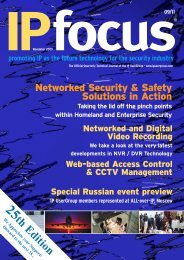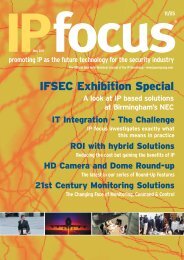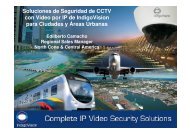IPfocus - IP UserGroup
IPfocus - IP UserGroup
IPfocus - IP UserGroup
Create successful ePaper yourself
Turn your PDF publications into a flip-book with our unique Google optimized e-Paper software.
<strong><strong>IP</strong>focus</strong>A Sea of ChangeCCTV is going through an inexorable change: it is becoming part of the IT industry.CCTV traditionalists may dispute that, but it is already happening and it is affectingeveryone with an interest in CCTV. Systems are frequently now being specified on thebasis of connectivity over <strong>IP</strong> (Internet Protocol) LANs.by Mike Holt, Sirrus<strong>IP</strong>-based data networks are a standard facilitynowadays across businesses of all sizes and innew premises or any refit, network cabling isin there right after the mains power. The ideaof pulling extra dedicated CCTV cabling isincreasingly inappropriate and developers andIT departments are increasingly calling forCCTV which “lives” on the LAN.Networked delivery of video offerskey advantages over analoguePAL:●●●●Pictures can be viewed anywhere on alocal or wide area networkRecording servers become part of astandard IT infrastructureAll the components from cameras torecorders can be remotely managed<strong>IP</strong>-based CCTV is inherently remotemonitorableDVRs and NVRsDVR is the term the industry uses for a ‘digitalvideo recorder’. But it’s important toremember that the term DVR has been usedfor years to mean a device taking analoguePAL video signals as inputs, digitisinginternally, and recording them to hard disc.Recording of networked cameras – that is,cameras which do not use PAL but instead28_issue 3deliver their video already in digital form overthe network, requires something quitedifferent - a “turn-key” recorder that workslike a VCR did, but compatible right off thenetwork with the network camera types youwant to use. A box with a mains inlet and anethernet connection only.Being a network device at heart, we tend tocall this an NVR – a network video recorder.Network Appliance RecordersAn NVR is the IT industry calls a “networkappliance” – an intelligent device that sits on anetwork, doing a job. There are lots of networkappliances in IT – firewalls, routers, managedswitches, traffic shapers, load balancers, fileservers, all sorts - and NVRs are just newjoiners, to that well-established territory.A video recorder in the form of a networkappliance is a true “fit and forget” product –totally self-contained and self-managing.This is key to user’s expectations, and is whyan NVR needs to be a network appliance, notjust a desktop or server PC. No-one in IT wouldexpect to have to reboot a firewall, just as noonein CCTV expects to have to reboot amonitor. The same hard reliability is going toexpected of any video recorder – get on anddo the job, 24/7/365.So an NVR should be fully self-managing, incase of disconnection or power brownout.Here’s a little test to try out with yourfavourite PC-based NVR or DVR. Have thedealer demonstrate it, by configuring it torecord a batch of cameras. Then - withoutwarning - you pull the mains power lead outof the wall. Count to five, and plug it back in.Does the unit recover cleanly every timewithin a minute? Does it go straight back intorecording as it was before? Or does it dosomething rather less satisfactory? Resultscan be mixed.Recording Compatibility<strong>IP</strong>-CCTV is still a young industry and the manymakers of <strong>IP</strong> cameras and codecs have not yetarrived at a point of serious liaison with eachother. As a result there is limited commonground between maker’s technologies.As a result each camera or codecimplementation is slightly different, anddespite using supposedly open videocompression standards, manufacturers don’tagree common standards for transmissiondata formats, configuration or telemetrycontrol packets, for example. One householdnamemanufacturer has managed to squeezeFOUR different video compression standardsinto … three models of camera. Quite a feat.Look for an NVR which can record half a dozenor so of the premium makes of networkcameras – at the very least, compatibility withJVC, Sony, Sirrus, Axis, Mobotix for example.This makes it much easier to design networkCCTV systems.Viewing ToolsA good NVR will connect seamlessly to lots ofdifferent camera types and should offer younetworked viewing tools which give you bothmulti picture and full-screen viewing of any ofthe cameras. Archive playback should ofcourse offer easy-to-use VCR-like controls andthe ability to random-access the archive bytime and date.Copy tools should allow you to “clip” any partof the archive for burning to CD and also allowstream formats such as AVI to be created –this makes it simple to send evidential clipsby email.Look out for multi-screen display managementalso – you should be able to plan your controlroom or viewing workstation using multiplescreens, so that each operator can controlviews on many screens, from one location,just as you would have done with ananalogue matrix.














